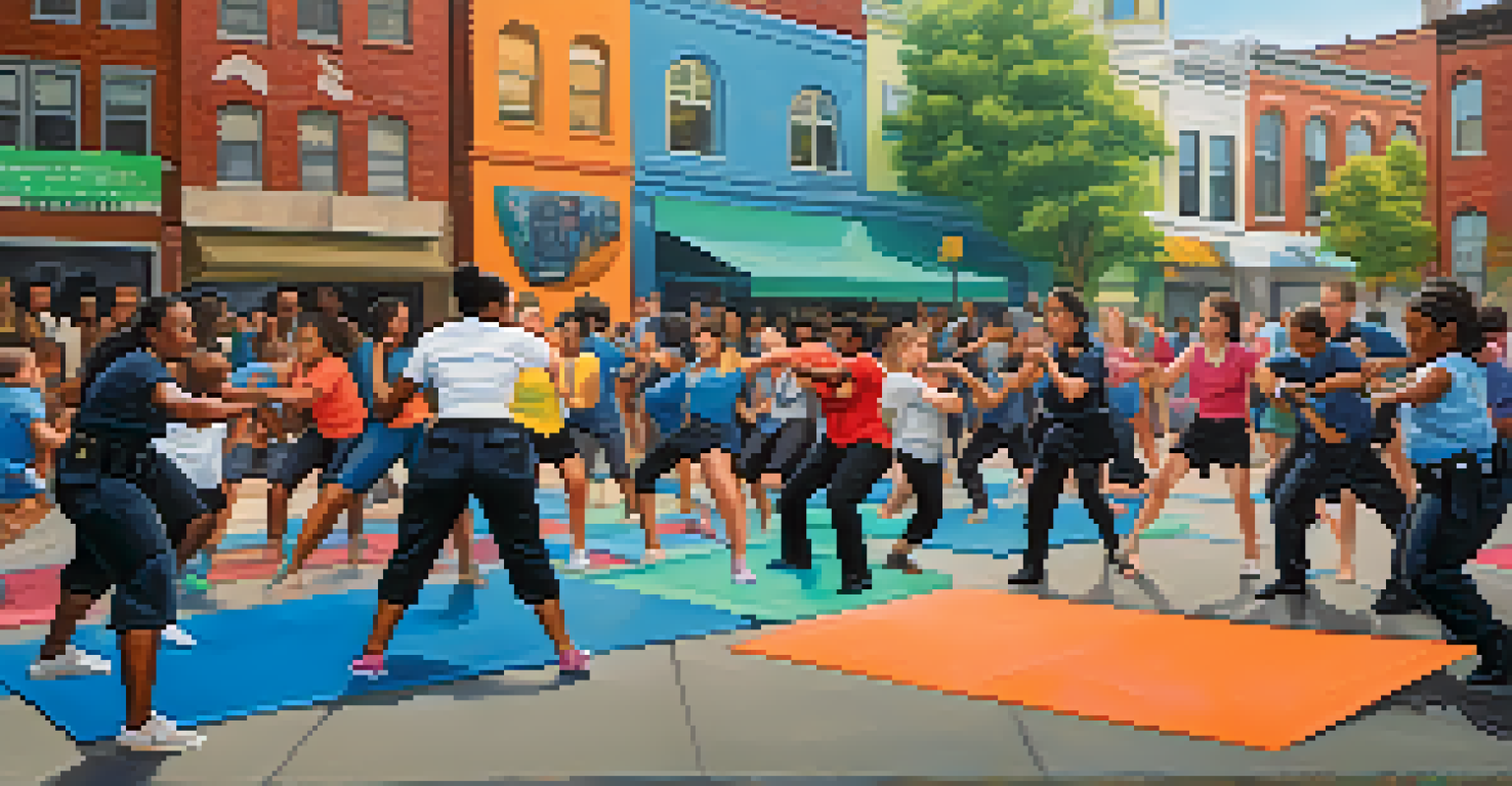Self Defense Strategies in Latin American Countries

Understanding the Context of Self Defense in Latin America
Self-defense in Latin America is often shaped by unique social and cultural factors. Many countries experience high levels of crime and violence, which leads individuals to seek out self-defense methods. Moreover, the legal frameworks around self-defense vary significantly from one country to another, influencing how citizens prepare themselves in potentially dangerous situations.
Self-defense is not just about fighting back; it's about understanding your environment and being prepared.
In countries like Brazil and Mexico, personal safety is a common concern, prompting communities to develop their own self-defense strategies. For example, informal workshops and classes are frequently organized in neighborhoods to teach basic self-defense skills. Understanding the local context is crucial for any effective self-defense approach, as it informs the types of techniques that may be most relevant.
Ultimately, recognizing the specific challenges faced by each country provides a foundation for effective self-defense strategies. It's not just about knowing how to fight; it's about being aware of the environment and legal implications that accompany self-defense actions.
Cultural Influences on Self Defense Practices
Cultural attitudes towards self-defense can greatly influence how individuals choose to protect themselves. In many Latin American countries, traditional martial arts and self-defense techniques are integrated into community practices. For example, Brazilian Jiu-Jitsu has gained immense popularity due to its effectiveness and cultural significance, providing not just physical skills but also a sense of community and belonging.

Additionally, the influence of local folklore and traditional beliefs plays a role in shaping self-defense practices. In some regions, ancestral teachings about combat and survival are passed down through generations, creating a rich tapestry of techniques that may not be formally recognized but have deep roots in the culture. This blend of modern and traditional approaches showcases the diversity of self-defense methods across the continent.
Self-Defense Influenced by Culture
Cultural factors and traditional practices significantly shape self-defense techniques in various Latin American countries.
Moreover, cultural events and festivals often incorporate self-defense demonstrations, further embedding these practices into daily life. By understanding these cultural nuances, one can better appreciate the self-defense landscape in Latin America.
Legal Frameworks Governing Self Defense
The legal aspects of self-defense vary significantly across Latin American countries, impacting how individuals can legally protect themselves. In some nations, laws are quite permissive, allowing individuals to use force to defend themselves or others in life-threatening situations. However, in other countries, the rules around proportionality and necessity can be much stricter.
Awareness is the first step in self-defense; the best fight is the one that never happens.
For instance, in Colombia, the right to self-defense is recognized, but excessive force can lead to legal consequences. Therefore, understanding the nuances of local laws is essential for anyone considering self-defense tactics. Legal knowledge empowers individuals to make informed decisions when faced with threatening situations.
Furthermore, there are ongoing discussions in many countries about reforming self-defense laws to better protect citizens. Advocacy groups are actively working to raise awareness about the importance of self-defense rights, which can lead to changes in legislation that benefit communities.
Popular Self Defense Techniques in Latin America
Across Latin America, various self-defense techniques have gained popularity due to their effectiveness and accessibility. Techniques such as Krav Maga, Muay Thai, and Capoeira not only provide physical skills but also encourage mental resilience. These martial arts emphasize the importance of awareness and quick thinking in potentially dangerous situations.
In urban areas, street self-defense classes often focus on practical techniques that can be used against common threats, such as muggings or assaults. These classes emphasize escaping from situations rather than engaging in prolonged combat, which is a crucial aspect of modern self-defense philosophy. The goal is to empower individuals to protect themselves without escalating violence unnecessarily.
Legal Nuances Impact Self-Defense
The legal frameworks governing self-defense vary widely across Latin America, affecting how individuals can protect themselves.
Moreover, many self-defense programs incorporate elements of situational awareness, teaching individuals how to recognize potential threats before they escalate. This holistic approach ensures that participants are not only equipped with physical techniques but also with the mental tools necessary for personal safety.
Community-Based Self Defense Initiatives
Community initiatives play a vital role in promoting self-defense awareness and skills in Latin America. Many neighborhoods organize workshops and training sessions aimed at empowering residents, particularly women and children, to defend themselves. These programs often foster a sense of solidarity and encourage community engagement, turning self-defense into a collective effort.
For example, in some cities, local police departments partner with community centers to offer free self-defense classes. These classes not only teach practical skills but also provide resources on legal rights and personal safety strategies. By involving local authorities, these initiatives can build trust and improve safety perceptions within the community.
Additionally, grassroots movements often emerge, focusing on self-defense as a means of social empowerment. These efforts highlight the importance of equipping individuals with the tools they need to navigate their environments safely, reinforcing the idea that everyone has the right to protect themselves.
Self Defense Technology: Apps and Devices
With the rise of technology, various self-defense tools and apps have emerged, making it easier for individuals to enhance their safety. From personal alarms to smartphone apps that track location and alert contacts in emergencies, technology is playing a pivotal role in modern self-defense strategies. These tools can provide peace of mind and a sense of security for users.
In many Latin American cities, apps designed specifically for personal safety have gained traction. These apps often include features like emergency alerts, location tracking, and direct communication with authorities. The convenience of having these resources at one's fingertips not only empowers users but also creates a community of support.
Community Initiatives Empower Safety
Community-based self-defense programs foster solidarity and teach residents valuable skills for personal safety.
However, it's important to remember that technology should complement, not replace, traditional self-defense training. While apps and devices can be helpful, they cannot substitute for skills and awareness developed through practice and education. A balanced approach that incorporates both technology and physical training is ideal for personal safety.
The Importance of Awareness and Prevention
Awareness and prevention are fundamental components of effective self-defense strategies. Being attuned to one’s surroundings and recognizing potential threats is often the first line of defense. This proactive mindset can significantly reduce the likelihood of dangerous encounters, allowing individuals to avoid escalation before it occurs.
In many self-defense classes, instructors emphasize situational awareness as a critical skill. Participants learn to identify patterns of behavior that may indicate trouble, such as aggressive posturing or suspicious activity. By honing these skills, individuals can take proactive steps to ensure their safety.

Moreover, prevention strategies extend beyond individual actions; they involve community engagement and education. By fostering discussions around safety and self-defense, communities can create an environment where individuals feel empowered to protect themselves and others, ultimately leading to safer neighborhoods.